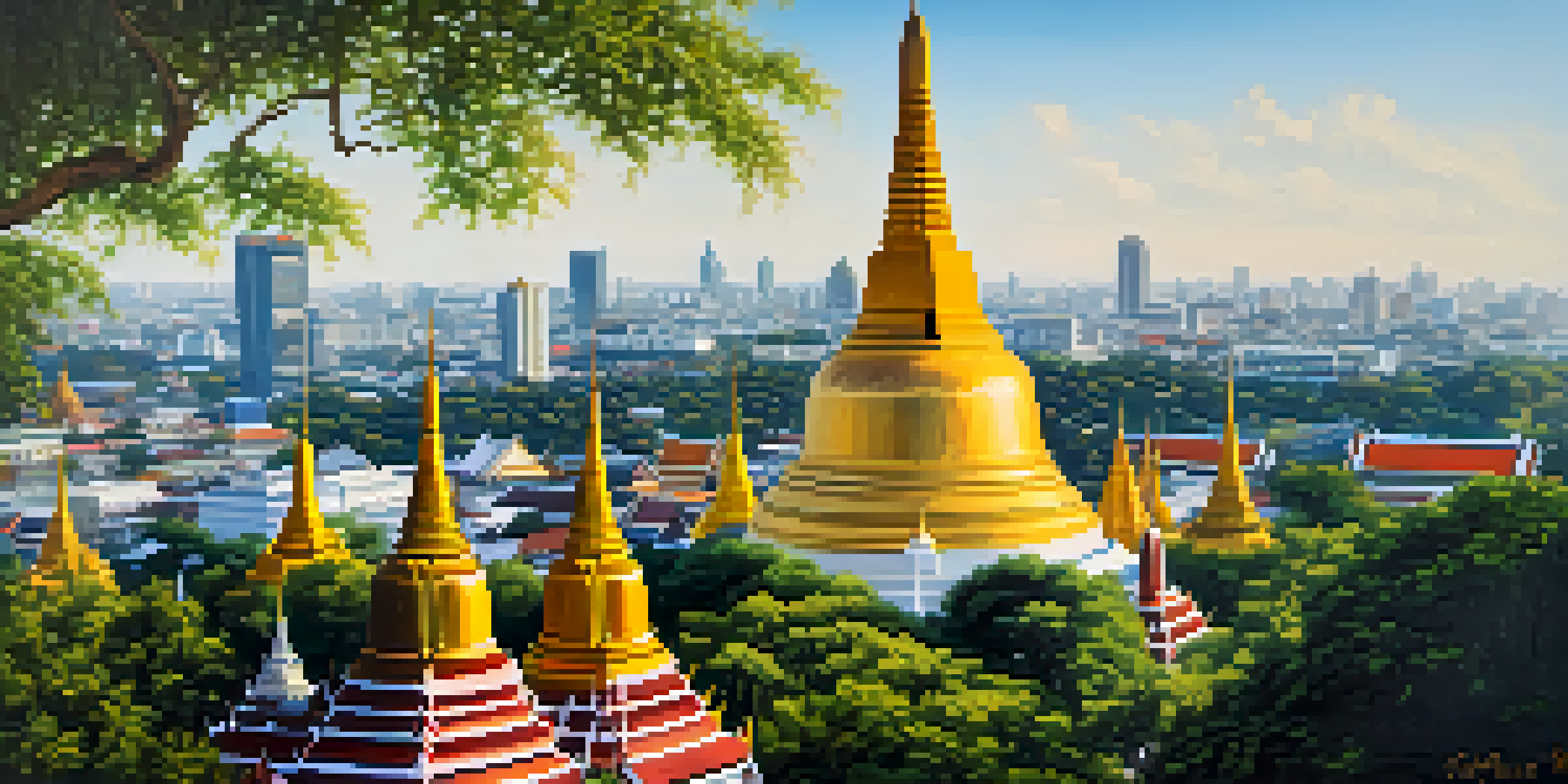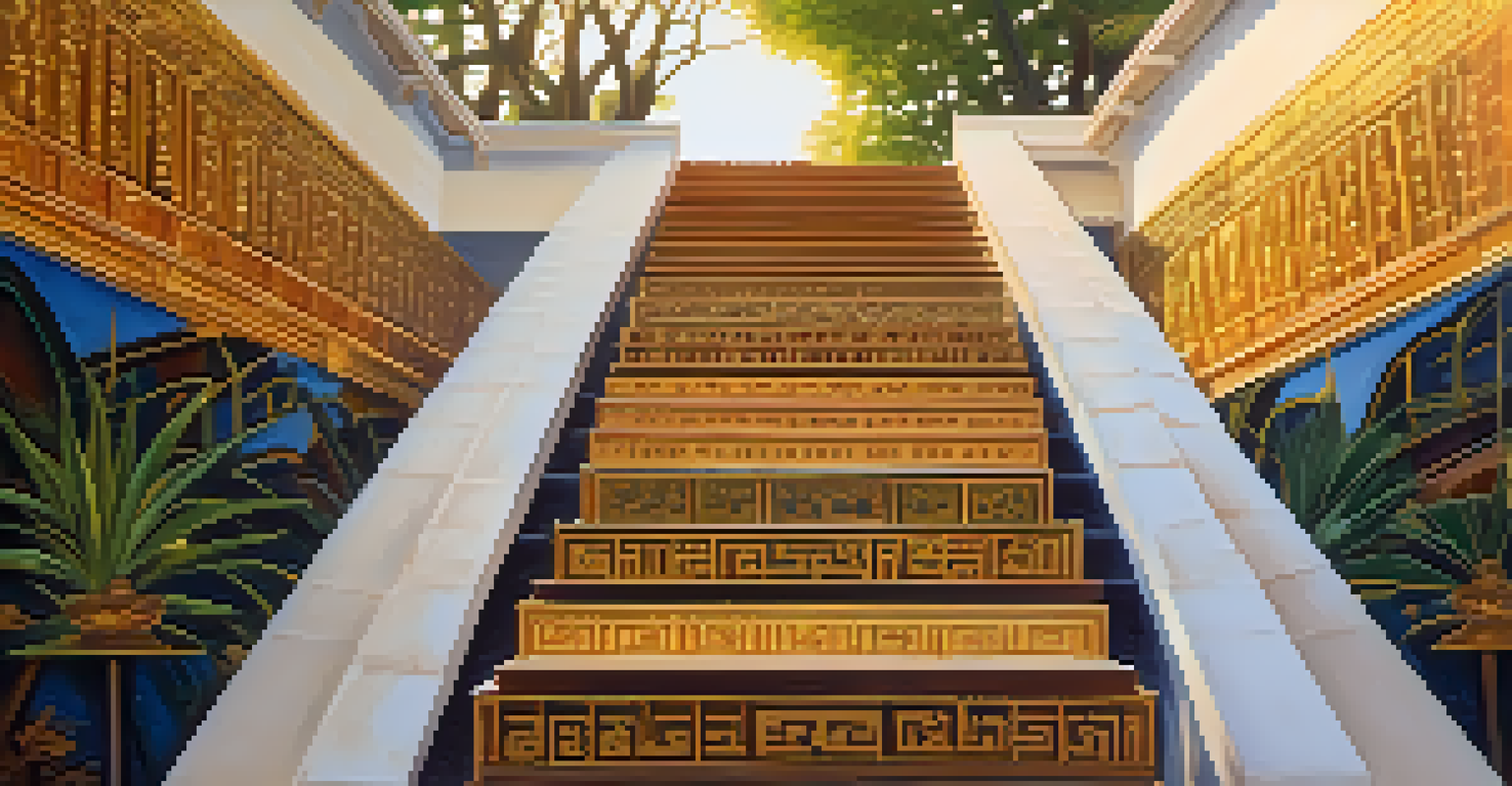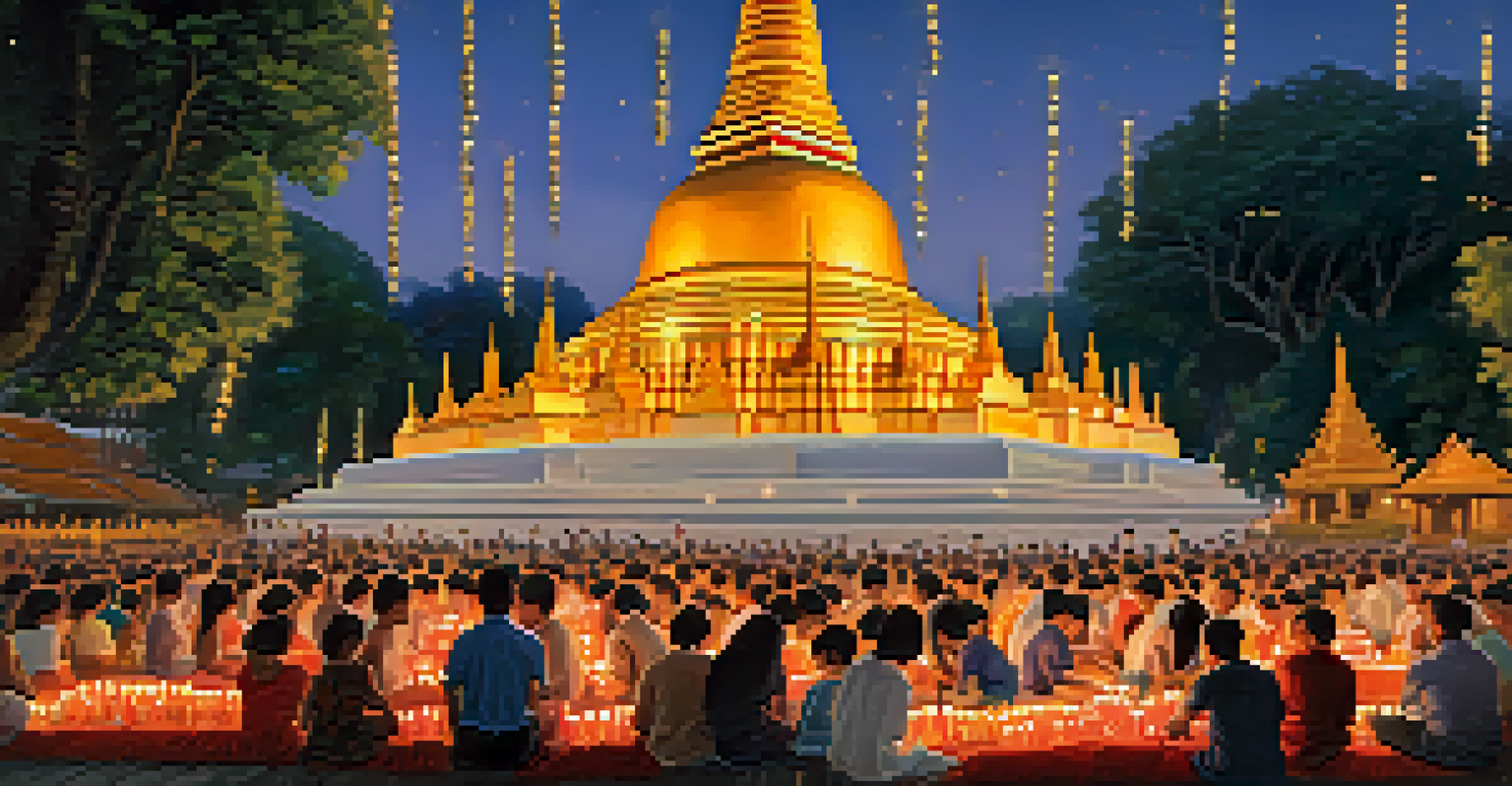Exploring the Myth of the Golden Mountain: Wat Saket

The Legend Behind Wat Saket and Its Golden Mountain
Wat Saket, also known as the Golden Mountain, is steeped in legend. According to local folklore, this ancient temple is said to be built atop a hill that once housed the cremated remains of the Buddha. This myth adds an air of mystique, making it a fascinating place for both locals and tourists alike, who come to explore its spiritual significance.
The journey of a thousand miles begins with one step.
The temple's golden chedi, or stupa, glimmers in the sunlight, symbolizing enlightenment and the quest for spiritual growth. As you ascend the hill, you can almost feel the weight of history pressing down, inviting visitors to reflect on their own life journeys. It's not just a physical climb; it's a metaphorical journey toward self-discovery.
Many believe that the Golden Mountain offers blessings to those who visit. The combination of the stunning views and the sacred atmosphere creates a unique experience that resonates with many. Whether you're seeking spiritual solace or simply curious about the legend, Wat Saket provides a compelling reason to explore.
A Historical Overview of Wat Saket
Dating back to the Ayutthaya period in the 18th century, Wat Saket has a rich history intertwined with Bangkok's development. Originally built as a royal temple, it has witnessed the rise and fall of dynasties and the evolution of Thai culture. Each brick and artifact tells a story, making it a living museum of sorts.

In the early 19th century, King Rama III made significant renovations to the temple, further establishing its importance. He had the original structure transformed into the magnificent chedi we see today. This ambitious project not only elevated the temple's stature but also solidified its role in the hearts of the Thai people.
Wat Saket's Rich Historical Roots
Dating back to the 18th century, Wat Saket has witnessed Bangkok's evolution as a royal temple, making it a living museum of Thai culture.
Wat Saket’s historical significance is further underscored by the annual pilgrimage during the Loy Krathong festival. Locals and tourists alike gather to pay their respects, illuminating the site with candles and offerings. This tradition keeps the spirit of Wat Saket alive, connecting the past with the present.
The Architecture of Wat Saket: A Closer Look
The architecture of Wat Saket is a beautiful blend of traditional Thai design and spiritual symbolism. The chedi is adorned with intricate golden tiles that reflect sunlight, creating a dazzling effect that draws the eye from afar. The climb to the top is lined with statues and murals that depict Buddhist teachings, enhancing the spiritual journey for visitors.
The temple is the heart of the city, a place where the sacred and the mundane intersect.
As you walk up the spiraling staircase, each step reveals new details, from the lush green surroundings to the ornate decorations. The design encourages visitors to pause and appreciate these elements, fostering a deeper understanding of the cultural significance. It's a perfect example of how architecture can tell a story.
Upon reaching the summit, you're rewarded not only with panoramic views of Bangkok but also a sense of accomplishment. The open-air platform allows for reflection, offering a moment to appreciate both the beauty of the city and the tranquility of the temple. This harmonious blend of nature and architecture creates a memorable experience.
The Spiritual Significance of Wat Saket
For many, Wat Saket is more than just a tourist attraction; it is a sacred space for spiritual reflection. The temple serves as a reminder of the teachings of the Buddha, encouraging visitors to contemplate their own lives and actions. The atmosphere is permeated with a sense of peace that is palpable as you wander through its grounds.
Every year, thousands of pilgrims visit the temple to participate in rituals and ceremonies, demonstrating the ongoing relevance of Wat Saket in modern Thai society. Whether it's lighting incense or making merit, these practices connect the community to their spiritual roots. It’s a beautiful sight to see people from all walks of life come together in reverence.
Spiritual Journey Up the Mountain
The climb to Wat Saket's summit is not just physical; it symbolizes a personal journey of self-discovery and spiritual reflection.
The temple's significance transcends mere architecture; it embodies a rich tapestry of beliefs and traditions that have persisted through the ages. This living heritage invites visitors to engage with Buddhism on a personal level, making it a must-visit for anyone interested in spiritual exploration.
Visiting Wat Saket: What to Expect
When planning a visit to Wat Saket, it's important to know what to expect. The trek up the Golden Mountain involves about 300 steps, so be prepared for a little workout. However, the journey is manageable for most, and the views along the way often provide ample motivation to keep going.
Visitors can explore the temple grounds and take part in various rituals, such as offering food to monks or participating in meditation sessions. These activities provide an immersive experience that enriches your understanding of Thai culture. It's not just about sightseeing; it's about engaging with the spiritual essence of the place.
Dress modestly when visiting, as Wat Saket is a sacred site. Respecting the customs and traditions enhances the experience for both you and the temple community. With a bit of preparation, your visit will be both enlightening and enjoyable, leaving you with memories to cherish.
Local Legends and Folklore Surrounding Wat Saket
Like many historical sites, Wat Saket is woven with local legends that add to its charm. One popular tale speaks of a mysterious spirit that guards the temple, believed to protect the faithful who visit. This folklore attracts curious travelers who are eager to learn more about the myths that envelop the site.
Another fascinating story involves the origins of the Golden Mountain itself. It's said that the hill was created from the ashes of the Buddha, making it a sacred place for reflection and reverence. Such narratives deepen the connection between the temple and its visitors, inviting them to explore these mystical elements.
Legends Enrich Visitor Experience
Local folklore surrounding Wat Saket, including tales of spirits and the sacred origins of the Golden Mountain, adds depth and intrigue to the visit.
These legends, passed down through generations, create an engaging atmosphere that captivates the imagination. Whether you're a believer or a skeptic, the stories enhance your experience, prompting you to look beyond the physical structure and into the heart of its significance.
Conclusion: The Enduring Allure of Wat Saket
In conclusion, Wat Saket, with its rich history, stunning architecture, and spiritual significance, remains a must-visit destination in Bangkok. Its legends and folklore add layers of intrigue, ensuring that visitors leave with more than just photographs; they leave with stories and reflections of their own. The Golden Mountain continues to be a beacon of spirituality and community.
As you stand at the summit, overlooking the vibrant city below, it's easy to feel a sense of connection to something greater than oneself. The experience of climbing Wat Saket extends far beyond the physical act; it’s a journey of the spirit. This unique aspect of the temple makes it a truly special place.

Whether you're drawn by the myths, the architecture, or the serenity, Wat Saket has something to offer everyone. It stands as a testament to the enduring allure of Bangkok's cultural heritage, inviting both locals and travelers to explore its wonders time and again.